Visiting friends and colleagues
We love to have friends, family members, and colleagues visiting us in La Paz. There are
many attractions in and around La Paz, but the cheapest and in my opinion most satisfying
is a hike in the mountains. In November 2000, Celia Cornejo and I brought our colleague
Rob Faris from Harvard University on a hike to "Muela del Diablo." It is an
afternoon hike that brings you from our house, up the mountains, through a little village,
to a rock called "The Devil's molar tooth", and down again trough a new and very
exclusive neighborhood. On the way there are some spectacular views of the city below. 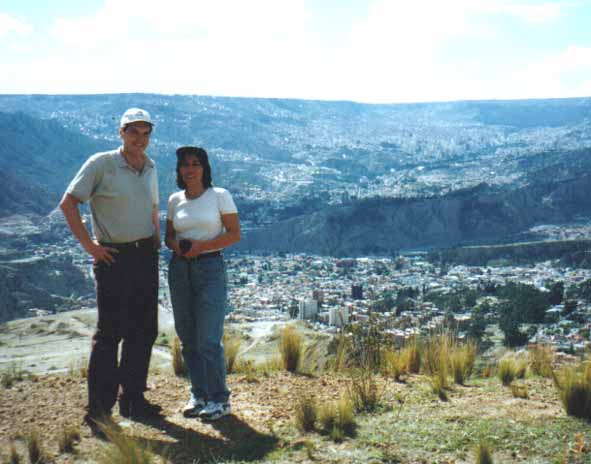
Robert Faris and Celia Cornejo, La Paz, November 2000.
During December 2000 we enjoyed the visits of Diana Weinhold from London
School of Economics and Manfred Wiebelt from Kiel Institute of World Economics. The three
of us hiked up to the local ski-resort in La Paz, Chacaltaya at 5.300 meters above sea
level. It was great to feel snow again, but the cosmic rays are so strong there that even
on a completely cloudy day I got a severe sun burn. Diana was smarter than I. When we
passed the observatory where they collect and study cosmic rays, she figured that it was a
good idea to shield herself against them, and she put her thick coat over her head.
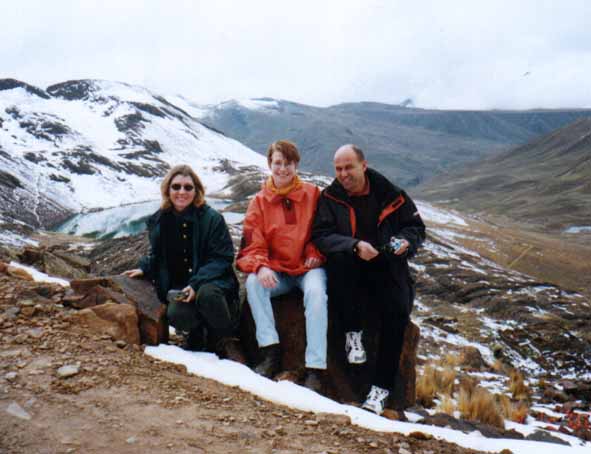
Diana Weinhold, Lykke Andersen, and Manfred Wiebelt, Chacaltaya,
December 2000.
|
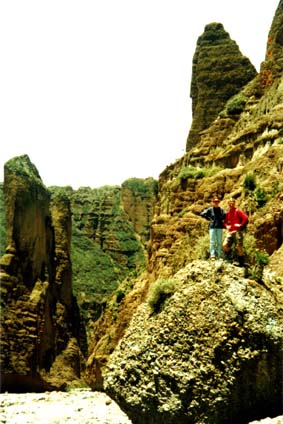
Lykke Andersen and Per Skrumsager,
Palka trail, February 2001.
|
In February 2001, my
parents and Per, an old friend from highschool and university, came to visit us and my
father, Per and I did the beautiful 5 hour hike from Ovejuyo to Palka. Part of the trip
you have to walk in a riverbed and it is generally not recommended to do it in the rainy
season, but we did it anyway and it added some challenges. The river cuts through clay
mountains, which means that you at times walk between 50 meter high walls of clay. In the
rainy season large chunks of clay fall down regularly, which is why it is not recommended
to be walking there
The biggest challenge, however, is to find a ride back to La Paz from Palka. Otherwise
it becomes a very long day of walking.
To the left is Per and I standing on a rock by the riverbed. |
Julius Spatz from Kiel Instute for World Economics was visiting researcher at IISEC for
some months in 2002 and 2003. One Saturday we invited him to attend an Aymaran ceremony
for improving our luck. A few days after the ceremony he got an article accepted for
publication, so he concluded that it works.Below he is getting his future read in
coca-leaves by an Aymara witch doctor.
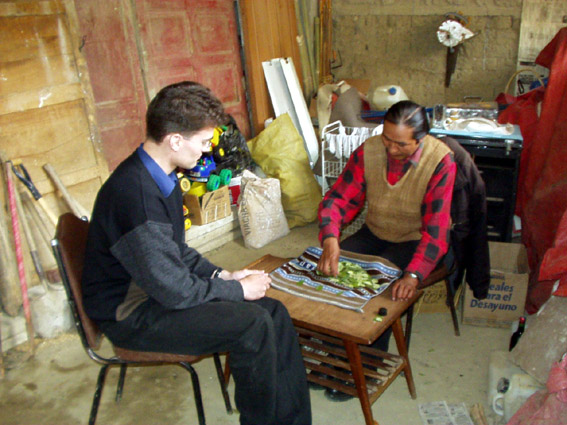
Julius Spatz getting his future read in coca-leaves, January 2003.
My
mother, my aunt Anny, and my cousin Mia were not so lucky when
they came to visit us in October 2003. They arrived just the day
before the revolution broke out and the city of La Paz was closed
down. I was lucky to get them down from the airport on some of the
last drops of gasoline in the city, but then we spent a week
locked inside our house, because the Danish Embassy called every
day and told us that it was too dangerous to go out. We did sneak
out every day anyway, just to see what was going on and to see if
we could find some food. This is what Calle 25 in Los Pinos looked
like one morning. 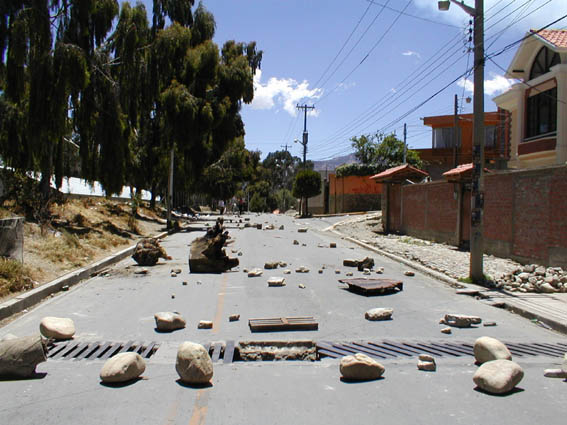
Our neighborhood, Los Pinos, during the
October 2003 revolution in La Paz.
It
was a frustrating period because nobody knew how long it would last.
I was alone with the three kids, because Osvaldo was stuck in Chile
and his flight to La Paz for the kids' Birthdays was cancelled and
my cook and babysitters were all stuck in other parts of La Paz. So
for me it was extremely lucky to get help from Denmark. The other
good thing was that the weather was absolutely perfect and the kids
were playing with water in the garden all week, happy to get an
unexpected vacation, but sad that their Birthday parties had to be
cancelled. My family had good insurances and their respective
insurance companies had agreed to organize and pay for evacuation,
but just when they were ready to leave with a helicopter, the
President of Bolivia resigned and everything returned to normal
again. The following morning, there were food in the stores and
gasoline on the gasoline stations and when we went for a walk
downtown I heard a Bolivian man comment "Oh, the tourists have
returned, that's great!"
|
|
|